Long Beach
-
- West Coast Intermodal Update: Mario Cordero Maritime Logistics Professional, Sep/Oct 2017 #14
POLB Executive Director Mario Cordero weighs in from his new West Coast chair, on the most pressing issues of the day. Arguably the industry authority from both the regulatory and commercial sides of the equation, his opinion carries weight and, sometimes, surprises.
It has been a busy year at the port of Long Beach, Calif. Lou Anne Bynum, Harbor Commission President at the Port of Long Beach, declared in early October, “Simply put, we are having the best trade months in port history.” Indeed, the port moved more containers last month than in any September in its history. The 701,619 twenty-foot equivalent units (TEUs) processed in Long Beach for September — up 28.3 percent — resulted in the port’s best quarter ever. In the third quarter, the Port of Long Beach handled 2,114,306 TEUs, as volumes swelled 15.9 percent over the same period last year.Imports increased 29.5 percent in September to 366,298 TEUs. Exports rose 4.1 percent, to 125,336 containers. Empty containers moving out of Long Beach to be refilled with goods overseas totaled 209,985 TEUs, up 46.4 percent. But, says the port, the huge jump in cargo last month relative to a year ago is only partly due to the Hanjin bankruptcy that hit West Coast ports in September 2016. But, there’s much more than that to report.In April, the nationwide search for the Port of Long Beach’s Executive director ended, when the Long Beach Board of Harbor Commissioners voted to name Cordero, former chairman and member of the Federal Maritime Commission (FMC), as the Port of Long Beach’s new Executive Director. Cordero brings to Long Beach considerable experience, both in terms of global commercial savvy, and as someone who knows his way around the Hill.Cordero, a Long Beach resident and attorney, served previously as president of the Long Beach Board of Harbor Commissioners. His tenure at FMC stretches back to 2011, where he served as chairman from April 2013 until January 2017. Today, he oversees the nation’s second-busiest seaport, leading the port’s Harbor Department staff of more than 500 people with an annual budget of nearly $800 million.In October, Cordero sat down with MLPro Editor Joseph Keefe at the annual AAPA Conference for a one-on-one discussion that ran the full gamut of local port issues; from local chassis issues, all the way to global market drivers.Many economists insist that the economy is “in a sweet spot right now.” Projections are for the global economy to grow more than 3 percent in next year. On the other hand, in order to plan, port executives need to know what’s going to happen a decade from now. What are you planning for?In the latest panel here [at AAPA], I gave the report of what’s been forecasted. In 2040, you’re looking to the tune of maybe 40 million TEU’s. In 2025; somewhere in the neighborhood of 27 million TEUs. So it is significant growth, and when I say ‘significant,’ these weren’t the expectations that were made early on. And, to be more specific, 2030 we’re projecting to 28.3 million TEU’s, in 2040, 41 million. This year, we’re seeing growth – at least for the calendar year – to the tune of 6.4 percent, so our projection is 7 percent.Your predecessor told me in March that you [Long Beach] are nowhere near capacity and you could do a lot more with what you have. Where do you see your capacity at right now? If you had to go to maximum capacity right now inside these terminals that you have, what do you think you could handle?Let me give you a good example of that question. Our latest development of our terminal is the Long Beach Container terminal. After Phase 3, and we’re entering the last phase of that project, after Phase 3, it was scheduled to be completed late 2019. That terminal alone will be able to move 3.5 million containers. So it actually will be double of what that container terminal was able to move in years past, prior to this development.So, that’s just around the corner?That’s just around the corner. We have six terminals on the Long Beach side, container terminals; four of which I think will have capacity that will be significant, given that those terminals will have the ability, in the case of Long Beach Container Terminal, of receiving a vessel as large as a 22,000 TEU capacity. I think that we’re prepared for this cargo growth and I feel very optimistic that we will have that capacity.One of the issues that the Northwest Seaport Alliance [Tacoma and Seattle] struggles with is when and how and how to pay for opening up for night operations. They’d love to open up for night operations, but they need to figure out who’s going to pay for it. How many hours a day are your ports open right now?Presently, we do have night gates here at the Port of Long Beach. And we have it, that being facilitated by way of the Pier Pass program, which as you know, involves a traffic mitigation fee to address this issue about paying for that night gate. So having said all that, what we need is night gates that are predictable. I’m talking about something that’s sustainable and predictable. So the good news is we do have night gates now that we have been moving forward, but it’s not at the point that I believe has been maximized in order to prepare us to move the kind of volume that we’re expecting. How you measure the success of a night gate is in the truck turn time. Right now this is a challenge for many gateways, and we’ve made some movement on that, but at the end of the day, I think to your point, the real question is “Who’s going to pay for it?” Here in Long Beach and this greater port called LA/Long Beach, Pier Pass was an answer to that. But again, we still have to fine tune that so that, again, we have night gates that are predictable and true night gates, because you’re not going to be able to move this cargo between 8 and 5.Let’s shift gears a little bit. When you think about chassis, on the surface, it might not be the most interesting topic in the world. But, on the intermodal docks, it is one of the most important. Tell us about your ideal chassis pool and why it works best.Sometimes, there’s a misperception that we don’t have enough chassis. For example, in the Southern California Port Complex, I think we have somewhere in the neighborhood of from 90 to 100,000 chassis. When a problem does occur, it’s not because of not enough chassis, it’s a misallocation of chassis assets. That mutual manager – what we call a ‘gray pool’ – would have the ability to have chassis at like a staging area where people could pick up and return them. That creates efficiency and that maximizes productivity. In this country, we have three major equipment operators. So if we get those people together to find a common ground, then I think we’ll make some real productive steps.You said that your goal is, in the very near future, to go to 50 percent rail off the dock.Our goal is 50 percent – in the near future, 35 percent and then, ultimately 50 percent. It’s absolutely paramount to have an inland connectivity.Let’s talk about CAAP – the California Clear Air Action Plan. The ports have already done a remarkable job and I think the record speaks for itself. All the low-hanging fruit is gone. And the last 3 to 4 percent is going to be 5 times as expensive as the first 95 percent. Can you get to this zero percent [port emissions] in 2030?I believe we can. I think, in fact, the question is in terms of whether or not the technology is available by that time. If you look forward to 2030, which is the goal that is set for cargo handling equipment, and the 2035 goal for zero-emission trucks, technology is moving so fast that I’m very optimistic that option will be there. The question is what will be the cost and who’s going to pay for it. Those are fair questions. So, for us, it’s a full court press to seek government funding to achieve this goal. That is the option that we are seeking, because again, this whole issue of the environmental push to reduce emission is a politically-captured event. It’s not just happening in California – it’s happening throughout the nation, in various forms, of course. It’s happening throughout the global community. I just came back from China, in Shanghai, and in that city of millions and millions of people, scooters are all electric. I was amazed. I think the point I’m trying to make is that the political will is there to get to zero emissions. The Clean Air Action Plan is a living document – I want to make that clear, it’s not something that’s set in stone. The goal is to get to zero emissions and right now my colleague on the [AAPA] panel, Mark Sisson, was quoted in a recent maritime article that in his view, you could get to 82 percent zero emission cargo handling equipment at the cost of 1 billion dollars. That’s a lot of money. But, there is a debate: is it going to cost 1 billion dollars or is it going to cost far in excess of that? I think the market ultimately will answer that question, but what I want to make clear, what my message is, what our message is as ports, is that this is all dependent on government funding, because I believe government funding to do this is very realistic.International Trade Economist and Advisor Jock O’Connell gave a very good talk on trade economics. In that talk, he said, “Pulling out of TPP was incredibly disappointingfor California.” Would you agree?I agree, because again, international trade and the globalized concept, there’s no back-step to that. Nothing’s going to change. The Trans-Pacific Partnership agreement involved 12 nations that together, made up as much as 40 percent of the world’s GDP. When people ask me this question, I would suggest that we just step back and say, ‘What’s our competition doing?’ Like President Obama would say many times, do you want to set the tone of your own destiny or do you want somebody else to do that? So I think for California, specifically, it was unfortunate that this didn’t move forward because it would have been very, very important to the West Coast because the middle class of the world is going to be a great opportunity for the American export market. By 2050, just China alone is forecasted to be the largest middle class in the world. I think that’s an opportunity for the United States – particularly for the agrarian and agriculture sectors. You saw that China now is accepting American beef exports. What it means to our economy and for that particular commodity is in the billions. So going back to your question, I think, yes, that was a mistake.What can you bring from the experience at FMC to the Port of Long Beach that’s going to improve things here? And, what can the Port of Long Beach teach FMC about what they could be doing better?I was at the right place at the right time as it relates to the FMC. Why? Because I was able to, as chairman of the FMC, navigate the filing of the P3, the first of what I call the New Generation of Alliances, these major carriers who were coming together with vessel sharing agreements. The P3 eventually was withdrawn, but I was there to navigate that, until the last filing. So, I think that through the experience in understanding alliances, and understanding the importance of those relationships that I was able to gather from those discussions, I believe that I bring value to the Port of Long Beach Based on that experience, it’s a new day in terms of the maritime port authority industry. When you’re no longer negotiating or dealing with just one carrier, you’re dealing with an alliance that represents four carriers; in this case we’re down to three alliances. The second and last answer to that part of the question rests in the understanding of the supply chain. At the FMC we studied that. It was a national study: the movement towards this inland connectivity and moving a container not just when it arrives, unloading and loading, or even within the terminal – but also following the movement of that container throughout the supply chain. At the end of the day, that’s important at Long Beach because our market share is also dependent on it. Because of our proximity to Asia, we could get that container to Chicago and the Ohio Valley 11 days quicker than the direct water route from Shanghai to the East Coast. Now, what can FMC learn from Long Beach? Long Beach is part of the nation’s largest port complex. When you talk about the movement of cargo – and the mission of the FMC is to foster the efficient and reliable movement of waterborne international cargo – what better place to start than to look at the nation’s largest port complex? I think what the FMC needs to learn from Long Beach is “how does this work or not work?” Anytime you’re part of the nation’s largest port complex, collectively moving 340 billion dollars’ worth of cargo, it’s a case study that will benefit any business plan, especially in terms of how we move the cargo and how we address efficiency in the supply chain.(As published in the September/October 2017 edition of Maritime Logistics Professional) -
- Port of Long Beach: The Green Port Maritime Logistics Professional, Mar/Apr 2017 #23
There are two kinds of green. At Long Beach, the commitment to environmental progress remains at the forefront of the port’s business plan. That’s just smart business. A March 2017 visit to the Port of Long Beach provided a close-up view of one of America’s premier seaports. Most stakeholders already
-
- Los Angeles-Long Beach Propeller Club Names Officers For 1978-79 Term Maritime Reporter, Oct 15, 1978 #18
1978-79 term are: Lew Coppersmith, president; Richard J. Jacobsen, J.A. Jacobsen & Associates, first vice president ; H. Lee Sellers Jr., Port of Long Beach, second vice president; M.H.K. Aschemeyer, Delta Steamship Lines, Inc., third vice president, and Gordon A. Menendez, Waterman Steamship Corp
-
- Driving Efficiently Towards Zero Emissions Maritime Logistics Professional, May/Jun 2018 #40
As the Port of Long Beach Starts Year-long Freight and electric vehicle (EV) testing, Kalmar’s newest workhorse – the Kalmar Ottawa Electric terminal tractor, T2E – will be doing some of the heavy lifting. As California presses on with state-wide transportation electrification (TE), new equipment is starting
-
- Long Beach-Greater Los Angeles Section Of ASNE Discusses Union Oil's Tanker S/S Sansinena Maritime Reporter, Jan 1978 #46
The Long Beach-Greater Los Angeles Section of the American Society of Naval Engineers, Inc. held its November meeting at the Ports O'Call Restaurant, overlooking the Los Angeles Harbor in San Pedro. Following dinner, Philip Finkelstein, chairman of the Section, started the business and technical sessio
-
- ASNE And SNAME Members Tour Long Beach Naval Yard Complex Maritime Reporter, Aug 1978 #46
The June meeting of the Long Beach- Greater Los Angeles Section of The American Society of Naval Engineers was held jointly with the Los Angeles Metropolitan Section of The Society of Naval Architects and Marine Engineers. The more than 160 participants who were members of each or both Societies
-
- ASNE Long Beach-Greater Los Angeles Section Discusses Corrosion Protection And Control Maritime Reporter, Dec 15, 1978 #30
The October meeting of the Long Beach-Greater Los Angeles Section of The American Society of Naval Engineers was held in the Princess Room of the S/S Princess Louise Restaurant in San Pedro, Calif. The members and guests enjoyed the fellowship of meeting and greeting old friends and new acquaintance
-
- Long Beach Pilots Go Far Out With New Boat Maritime Reporter, Oct 2003 #72
Jacobsen Pilot Service Inc., Long Beach Calif. Received a new 54-ft. (16.4-m) welded aluminum pilot boat from Hike Metal Products Ltd. in Wheatley, Ontario, Canada this past July. Hike Metal was approached in the early summer of 2002 after Jacobsen Pilots services owner Tom Jacobsen had conducted a
-
- Report On Laser Technology Made To ASNE Long-Beach-Greater L.A. Section Maritime Reporter, Nov 15, 1981 #58
The first meeting of the 1981- 82 year for the Long Beach- Greater Los Angeles Section of ASNE was held recently at the Los Alamitos Armed Forces Reserve Center Officers Club. Following dinner, Capt. J.A. Gildea, USN, chairman, welcomed the 57 members and guests. Chairman Gildea next introduced the
-
- Underway Replenishment Machinery Topic At Long Beach/LA ASNE Maritime Reporter, Jul 1981 #40
The Long Beach/Greater Los Angeles Section of the American Society of Naval Engineers held a recent regular meeting at the officers club of the Los Alamitos Armed Forces Reserve Center. Capt. J.A. Gildea, USN, Section chairman, welcomed those present and recounted several of the more meaningful
-
- Long Beach Terminal Orders Two Additional Transtainer Cranes Maritime Reporter, Apr 15, 1981 #9
Long Beach Container Terminal, Inc., recently ordered two Transtainer® cranes from Paceco, Inc. of Alameda, Calif. Paceco, worldwide manufacturer of dockside, terminal, and shipboard container handling cranes, is a subsidiary of Fruehauf Corporation, Detroit. The two r u b b e r - t i r ed Transtaine
-
- Long Beach-Los Angeles ASNE Elects New Officers Maritime Reporter, Apr 15, 1981 #54
The Long Beach-Greater Los Angeles Section of The American Society of Naval Engineers held a recent regular monthly meeting at the Officers Club of the Armed Forces Reserve Center, Los Alamitos, Calif. The meeting was the occasion of the installation of the new Section officers for the forthcoming ye
-
 )
March 2024 - Marine Technology Reporter page: 45
)
March 2024 - Marine Technology Reporter page: 45ronments. The new agreement will address speci? c techni- cal gaps in the UUV defense and offshore energy markets especially for long duration, multi-payload mission opera- tions where communications are often denied or restricted. As part of the new alliance, Metron’s Resilient Mission Autonomy portfolio
-
 )
March 2024 - Marine Technology Reporter page: 44
)
March 2024 - Marine Technology Reporter page: 44hardware and software solutions to Oi ‘24. In addition, featured were the HIPS & SIPS 12 release, with Featured were Optech CL-360 Marine, a 360-degree long- new work? ows for multiple frequency datasets and creating/ range laser scanner combining a scan speed of 250 lines per managing vessel ? les. second
-
 )
March 2024 - Marine Technology Reporter page: 41
)
March 2024 - Marine Technology Reporter page: 41locomotion, resulting in the AUV’s remarkable hydrodynamic properties. With its low-drag shape, The Greensea IQ booth @ Oi impressed. There we found long-time the Quadroin achieves speeds of up to 10 knots, minimizing friend and Greensea IQ CGO Rob Howard for an early start. energy consumption and
-
 )
March 2024 - Marine Technology Reporter page: 40
)
March 2024 - Marine Technology Reporter page: 40Vehicles to withstand the most severe ocean conditions, the new DriX (ROVs), as well as Autonomous Underwater Vehicles (AUVs). O-16 has been designed for long-duration operations (up to Its gondola, located below the surface, can further host a wide 30 days) and can deploy multiple payloads and subsea assets
-
 )
March 2024 - Marine Technology Reporter page: 38
)
March 2024 - Marine Technology Reporter page: 38. The basic model tions, largely due to their lower internal resistance. NiMH can is an affordable $189, while the Pro version is just $40 more. suffer longevity issues with deep discharge, but this may not be The CBA measures the actual amount of energy stored in a an issue if only a limited number of
-
 )
March 2024 - Marine Technology Reporter page: 32
)
March 2024 - Marine Technology Reporter page: 32the hold of the Hidden Gem. All images this page courtesy of TMC Engineers attach ? oat sections to the ? exible jumper hose that connects the four-km-long airlift riser pipe to the collector vehicle on the sea? oor. 32 March/April 2024 MTR #3 (18-33).indd 32 4/4/2024 9:16:09 A
-
 )
March 2024 - Marine Technology Reporter page: 19
)
March 2024 - Marine Technology Reporter page: 19current density can unlock new savings across assets and locations by inform- (including coating breakdown for coated pipelines/structures), ing a decades long data-driven maintenance program based on Life time expectancy of the CP system in years (i.e. remaining highly accurate lifespan prediction for every
-
 )
March 2024 - Marine Technology Reporter page: 17
)
March 2024 - Marine Technology Reporter page: 17being buried in reducing the risk of spill events on pipelines to saving time seabed sediments or under rock dump (pipelines). and money across decades long maintenance regimes. Proximity or cell to cell technologies which also required There are several methods available for measuring CP condi- frequent
-
 )
March 2024 - Marine Technology Reporter page: 13
)
March 2024 - Marine Technology Reporter page: 13at TWR. A familiar with the popular- so did demand for increased capabil- The Slocum Sentinel Glider scales ity this type of platform has seen over ity: longer missions, more sensors – the standard Slocum Glider through an the past two decades, growing from especially high-energy sensors – and increased
-
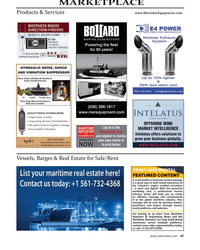 )
April 2024 - Maritime Reporter and Engineering News page: 47
)
April 2024 - Maritime Reporter and Engineering News page: 47Equipment Three Stage Noise & PulsaO on in ReducO on Chamber (206) 286-1817 www.merequipment.com QUALITY NACOL ACCUMULATORS • Forged shells, no welds • Long LasO ng, No Seam, Pleated Bladders OFFSHORE WIND • We stock 1/5 pint to 15 gallons in Chicago Log on to the • Sizes available to 40 gallons MARKET
-
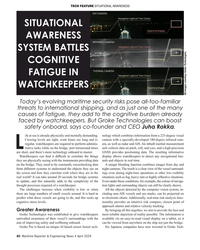 )
April 2024 - Maritime Reporter and Engineering News page: 40
)
April 2024 - Maritime Reporter and Engineering News page: 40at sea is already physically and mentally demanding. nology which combines information from a 225-degree visual Crewing levels are tight, work hours are long and ir- camera with a specially-developed 180-degree infrared cam- regular, watchkeepers are required to perform adminis- era, as well as radar and
-
 )
April 2024 - Maritime Reporter and Engineering News page: 38
)
April 2024 - Maritime Reporter and Engineering News page: 38which measures 12.5 x 5 m, plays a role in ing buoys. various port activities, including collecting MARPOL liquid The tanker vessel Archangel, 274 meters long and 85,474 and solid waste, transporting personnel and provisions, and oil gt, was moored using the 3-ton pulling capacity of the moor- spill response
-
 )
April 2024 - Maritime Reporter and Engineering News page: 32
)
April 2024 - Maritime Reporter and Engineering News page: 32campaign.” stacked vertically in marshalling areas, reducing their foot- NOV has launched the Enhydra ? oating wind installation print from around 150m long and 7m wide to just that of the vessel (FWIV) concept for the global market which is ex- diameter of the base. It also enables them to be moved with-
-
 )
April 2024 - Maritime Reporter and Engineering News page: 27
)
April 2024 - Maritime Reporter and Engineering News page: 27? rst ? ag of? cer job, and have the reliefs. involved in building the “MyNavy HR” portal as a mobile, That’s my concern if we get into a large-scale, long-term op- adaptive platform for the management of our active-duty eration. We can be reasonably certain that we won’t have all of people personnel
-
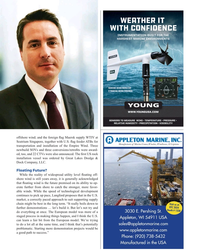 )
April 2024 - Maritime Reporter and Engineering News page: 23
)
April 2024 - Maritime Reporter and Engineering News page: 23continues to pick up pace, Langford proposes that in the U.S. market, a correctly paced approach to suit supporting supply chain might be best in the long term. “It really boils down to Visit us at OTC 2024 further demonstrations … let’s build it. But let’s not try and Booth # 1338 3030 E. Pershing
-
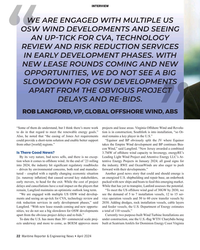 )
April 2024 - Maritime Reporter and Engineering News page: 22
)
April 2024 - Maritime Reporter and Engineering News page: 22have a real impact on the players that While that has yet to transpire, Lanford assesses the potential. remain, Langford maintains an optimistic outlook long term. “To meet the US offshore wind goal of 30GW by 2030, we “We are engaged with multiple US OSW wind develop- see the demand of 5 to 7 installation
-
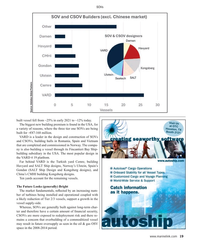 )
April 2024 - Maritime Reporter and Engineering News page: 19
)
April 2024 - Maritime Reporter and Engineering News page: 19and operational coupled with a likely reduction of Tier 2/3 vessels, support a growth in the vessel supply-side. Whereas, SOVs are generally built against long-term char- ter and therefore have a certain amount of ? nancial security, CSOVs are more exposed to redeployment risk and there re- mains a concern
-
 )
April 2024 - Maritime Reporter and Engineering News page: 18
)
April 2024 - Maritime Reporter and Engineering News page: 18carrier although hydrogen and liquid deployed to support construction logistics. South Korea, Ja- organic hydrogen carriers also feature. pan and, in the longer-term, Vietnam and Australia, are fore- Battery energy storage systems feature extensively as do cast to be the largest APAC offshore wind markets
-
 )
April 2024 - Maritime Reporter and Engineering News page: 16
)
April 2024 - Maritime Reporter and Engineering News page: 16are cost competitive, al- cranes, storage, and small workshop areas. though their use is relatively limited. SOV: Service operations vessels, generally on long- ¦Tier 1: purpose-built vessels for offshore wind with term charter to a wind turbine OEM or offshore wind in-built crane and gangway. farm operator
-
 )
April 2024 - Maritime Reporter and Engineering News page: 13
)
April 2024 - Maritime Reporter and Engineering News page: 13than a huge truck (EV or not) sustainability, but not if it achieved by introducing driving one person around. It is technically stupid, and quite long term carbon fuel use. frankly also economically unattractive from the driver’s point of If a liquid or other chemical fuel is needed, 7. view, since
-
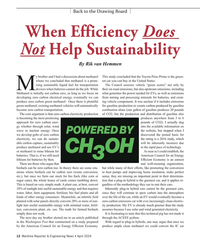 )
April 2024 - Maritime Reporter and Engineering News page: 12
)
April 2024 - Maritime Reporter and Engineering News page: 12when batteries cannot do the job. While their on-road emissions, but also upstream emissions, including Methanol is initially not carbon zero, as long as we focus on what generates the power needed for EVs, as well as emissions developing zero carbon electrical energy, eventually we can from mining
-
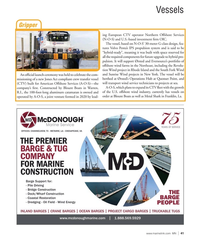 )
April 2024 - Marine News page: 41
)
April 2024 - Marine News page: 41projects at sea. A-O-S, which plans to expand its CTV ? eet with the growth company’s ? rst. Constructed by Blount Boats in Warren, R.I., the 100-foot-long aluminum catamaran is owned and of the U.S. offshore wind industry, currently has vessels on order at Blount Boats as well as Metal Shark in Franklin
-
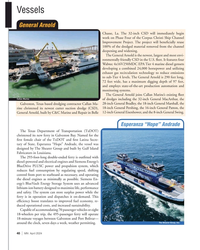 )
April 2024 - Marine News page: 40
)
April 2024 - Marine News page: 40a combined 24,000 horsepower and utilizing exhaust gas recirculation technology to reduce emissions to sub-Tier 4 levels. The General Arnold is 290 feet long, 72 feet wide, has a maximum digging depth of 97 feet, and employs state-of-the-art production automation and monitoring systems. The General Arnold
-
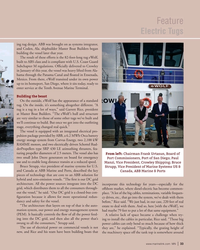 )
April 2024 - Marine News page: 33
)
April 2024 - Marine News page: 33systems integrator, and Coden, Ala. shipbuilder Master Boat Builders began building the vessel later that year. The result of these efforts is the 82-foot-long tug eWolf, built to ABS class and is compliant with U.S. Coast Guard Subchapter M regulations. Of? cially delivered to Crowley in January of this
